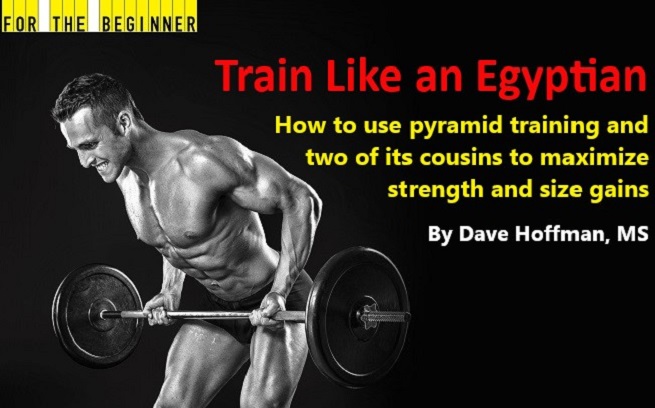How to Use Pyramid Training

How to use pyramid training and two of its cousins to maximize strength and size gains
One aspect of bodybuilding dates back several millennia to the ancient Egyptian civilization. No, they weren’t using barbells and dumbbells quite yet; however, their construction of pyramids is not unlike how lifters build pyramids into their training sequence today. What are pyramids in the context of bodybuilding and how can you get the most from them? Let’s find out.
In resistance training, a pyramid is a basic structure you create when arranging your sets and load for a given exercise. You start out light as a warm-up, and with every set you increase the weight, which can be shown in a graph (called an ascending pyramid).

It’s a pretty simple concept, really. Pyramid training has advantages for building size and strength, but it’s not perfect, so it has spawned a couple of variations. Here’s a quick look at some of the pros and cons when following an ascending pyramid.
1. One of the major advantages of the ascending pyramid is that it includes warm-up sets. You start out light and keep adding weight, which gets the target muscles warm and pliable, which is absolutely necessary for you to lift maximum poundages later in your workout.
Do as many warm-ups as you need, but stop well short of muscle failure when working up to your top weight. Accumulated fatigue adversely affects sets still to come, so you want to minimize it.
2. Pyramids are best suited for strength training. Bodybuilders take multiple sets to failure, but not powerlifters or when strength training. This allows strength-focused lifters to generate maximal power in those last 1 or 2 sets in which they need to move the heaviest loads.
3. Pyramids increase work volume. When following an ascending pyramid and increasing the weight on successive sets, you ultimately do a lot of total work (volume), which is a marker for muscle growth. Multiple-set training systems are better for inducing hypertrophy than single-set protocols.

Because pyramid training essentially means just 1 or 2 sets are to muscle failure (that point at which you can’t complete another rep on your own with good form), it may not be enough stimulus if you’re looking to maximize muscle size. Reaching muscle failure is important to initiate growth processes and is considered another marker for hypertrophy. Although this ascending pyramid works well for the person seeking gains in strength, it doesn’t work as well for the trainee looking to maximize muscle size.
If you’re looking to take multiple sets to muscle failure, a better system is the reverse (descending) pyramid. Here you start out with your heaviest weights (after a brief warm-up, which may be necessary on only your first exercise) for a low-to moderate rep count and then decrease the weight slightly on the sets that follow.
The reasoning is simple: If you fatigue your muscles on the first set and restrict your rest period to 60 to 90 seconds (such short rest intervals are another market for muscle growth, but you won’t be completely recovered by your next set; strength trainers, by the way, take 3- to 5-minute rest intervals), you won’t be as strong on your next set. This means you’ll do fewer reps or you’ll want to reduce the weight to ensure you keep your reps slightly higher. (When training to maximize muscle size, you rarely want to do fewer than 6 reps.)

Here are couple of advantages of descending pyramids.
1. You ensure fatigue levels are low on your heaviest sets. With fewer sets to burn you out before tackling your heaviest weights, you’ll be able to push the heaviest loads for the most reps possible, which translates into greater growth.
2. Descending pyramids allow you to reach muscle failure more often. When training for strength, you don’t want to frequently train to muscle failure, but when training for size, you do. With this type of pyramid, you hit failure right off the bat (after a few warm-ups, this is necessary only on your first exercise) and often. Your first and last working sets can be done to failure. Training to failure is a marker for maximizing the hypertrophic response (but not strength).
COMBINING THE PYRAMIDS
 You can combine elements of both pyramids in what’s called the triangle method (while slightly pulling back on the total number of sets). With triangles, you do a couple of warm-up sets, increasing the weight on each set to slowly prepare the targeted muscle but not taking those sets to muscle failure. After you do 1 or 2 sets with your heaviest weight, you follow a descending pyramid scheme using progressively lighter weights. All those last sets are taken to muscle failure.
You can combine elements of both pyramids in what’s called the triangle method (while slightly pulling back on the total number of sets). With triangles, you do a couple of warm-up sets, increasing the weight on each set to slowly prepare the targeted muscle but not taking those sets to muscle failure. After you do 1 or 2 sets with your heaviest weight, you follow a descending pyramid scheme using progressively lighter weights. All those last sets are taken to muscle failure.
Here, you get the volume and training to failure critical for mass building, as well as the opportunity to go to your heaviest weight without too many warm-ups.

